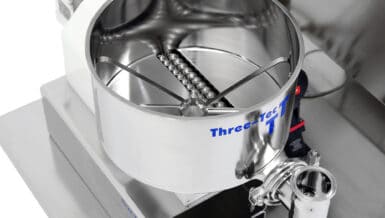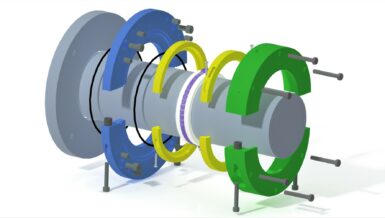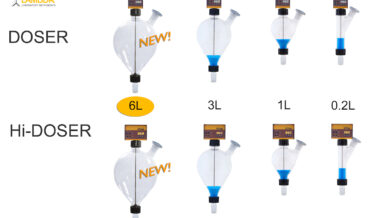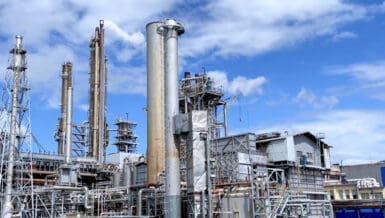Two Rand reports by Merrow, (1), (2), indicate that the efficiency of plants handling bulk solids compare unfavourably with those handling liquids and gasses and were barely improving over time. This trend seems to be continuing as the averages efficiency of current plants handling bulk materials averages around 80% of their design performance. Even this poor performance stands out remarkable from the indicated average output of 7% of design figures for plants handling biomass, where a performance of 80%, even for a short period, is said to considered an outstanding achievement. (3), At a time when it is essential to wean society away from oil and coal to sustainable fuel sources, a growth in biomass exploitation must be accompanied by a substantial improvement in the equipment performance to have a significant impact.
The Rand reports established that the reason for the low performance of solids handling plants did not lay on the chemical processes involved but almost invariably was due to problems of feeding and handling of the material. This feature is apparent in waste to energy projects that have failed completely, such as a £14,000,000 tyre handling plant at Wolverhampton and many others that have commissioning difficulties or limp along at much reduced capacities.
The science of bulk technology developed rapidly from the 1960’s and a design procedure for storage hoppers is now well established, (4). However, the first problem relating to ‘biomass’ handling is that the term embraces a huge range of bulk materials, many of which vary widely in composition and can exhibit very difficult flow properties. For reliable flow, the fractions of composition must shear and slip on the boundary contact surface. This process is resisted by materials that has high frictional or adhesive properties, or are stringy, flaky, irregular or have overlapping shapes and tend to form arches over hopper outlets, (5 – 22),
Apart from the problem of securing a ‘representative’ sample, such materials also resist established flow measuring techniques. In the absence of quantified data, the hopper design must be such that the contents drop clear of sliding contact restraint in the absence of any compression. i.e. the container walls must diverge. This state of discharge also requires the discharge device to generate extraction over the total outlet area of the container, not an easy task. (23), as the feeder also must support the weight of material in the container.
A second feature that exacerbates the feeding problem is that there is usually a need to provide a reliable seal to prevent leakage of noxious gasses from the process chamber to ambient on both the feeding and discharge. Air leakage can be restricted in the flow route by means of rotary valves or air lock, but these invariably allow a backflow by gas displacement on loading. Plug forming screws, that compacts the product in the feed channel such that the velocity of gas percolating back through the advancing plug is less than the rate of feed of the product, will effectively contain the process gasses.
The effectiveness of the plug seal is the key to gas containment. A feed screw therefore has two criteria to satisfy; to extract material from a hopper outlet that is sized to guarantee reliable flow and condition the material to a state of packing that resists backflow of gas in a plug that can be pushed through the feed channel available. The back flow of gas depends on the pressure differential, the cross- sectional area of the infeed channel, plug length and the plug permeability; permeability being a function of the nature of the bulk material and its state of packing.
A screw feeder can generate a high axial compression on the contents of the screw, but this results in a proportional increase in the transverse pressure on conventional screw casing walls with the consequential feed resisting friction force accumulating exponentially along the plug length, so limits the length of plug that can be moved. A wide range of design techniques are available, but considerable experience needed, to optimise the overall screw feeder construction based on measured values of flow related properties of the solid to be handled.
Refs.
- Merrow. E.W – Linking R&D to Problems Experienced in Solids Processing’ Rand report. 1984
- Merrow. E.W – A Quantitative Assessment of R&D Requirements for Solids Processing Technology, Rand report 1986
- Tyler. L – Biomass handling and feeding. DOI:10.5772/intechopen, 74606
- Bates. L. – Hopper design procedure. Ajax Equipment Publication.
- Miles. T.R. – Feeding preparation. Report prepared for the IEA thermal gasification activity. 1992 – 1994: 1992.
- Kosh. T. – Feed preparation of straw. Prepared by ELKCRAFT and the Danish Energy Agency for the IEA Biomass Thermal Gasification Activity. 1996
- Dia. J. – Overview and some issues relating to co-firings biomass and Coal. Canadian Jnl. Chemical Engineering.2008,86.367 – 86.
- Matterson. JE. – Basic handling characteristics of wood fuels, angle of Repose friction against surfaces and tendency to bridge for different assortments. Scandinavian journal of forest research.1990:5:583-97
- Matterson. JE – Tendency to bridge over openings for chopped phalaris and straw of triticum mixed in different proportions with wood chips. Biomass and bioenergy 1997.12.(3).199 – 210.
- Klauner. A – Handling characteristics of wood fuels – tendency to bridge over openings. Thesis. Fachochschule Rottenburg. 2001.
- Matterson. JE – Influence of cutting and storage method on bridging tendency. In chips and chunks made from willow shoots. Manuscript,2001
- Matterson. JE – Method and apparatus for measuring the tendency of solid biofuels to bridge over openings. Biomass and Bioenergy. 2002:22(3)179 – 85.
- Matterson. JE – Influence of particle size and moisture content on tendency to Bridge in biofuels made from willow chutes. Biomass and Bioenergy. 2003:24(6):429 – 35.
- Bundalli – Bin-feeder design for reliable flow of hog fuel. Pulp and Paper Canada. 1986:87(6):145 – 8.
- Ghaly. A – A development and evaluation of a straw feeding system for fluidized bed gasifier. Canadian bioenergy R & D seminar. Technical University of Nova Scotia. Halfax.1989:pp 297-303.
- van der Drift – Entrained flow gasification of biomass: ash behaviour, feeding issues and system analyses. ENC-C-04-039;2004.
- Rautalin. A – Feeding biomass into pressure and related safety engineering. VVT research notes No.1428.VVT Technical Research Center Of Finland. Task Study Report prepared for the IEA Biomass Thermal Activity; 1992.
- Jenson. P.D. – Tendency of wood fuel from whole trees, logging issues and roundwood to bridge over openings. Biomass and Bioenergy 2004:26:107 – 13.
- Bundalli. N. – Bin and Silos design for biomass materials. Phase 1, ENFOR project. C-130; 1982. Ottowa, Ontario.
- Nelson. D. – Development of a screw feeder for hogged bark and other wood refuse. Pulp and Paper. Canada. 1996;97(1):63 – 7.
- Joppich. A – Wood powder feeding, difficulties and solutions. Biomass and Bioenergy. 1999;16(3);191 – 8.
- Bates. L – Particle factors that effect flowability. Ajax publication.
- Bates. L. – Capturing the many elusive benefits of uniform extraction from storage hoppers. Ajax publication.










































